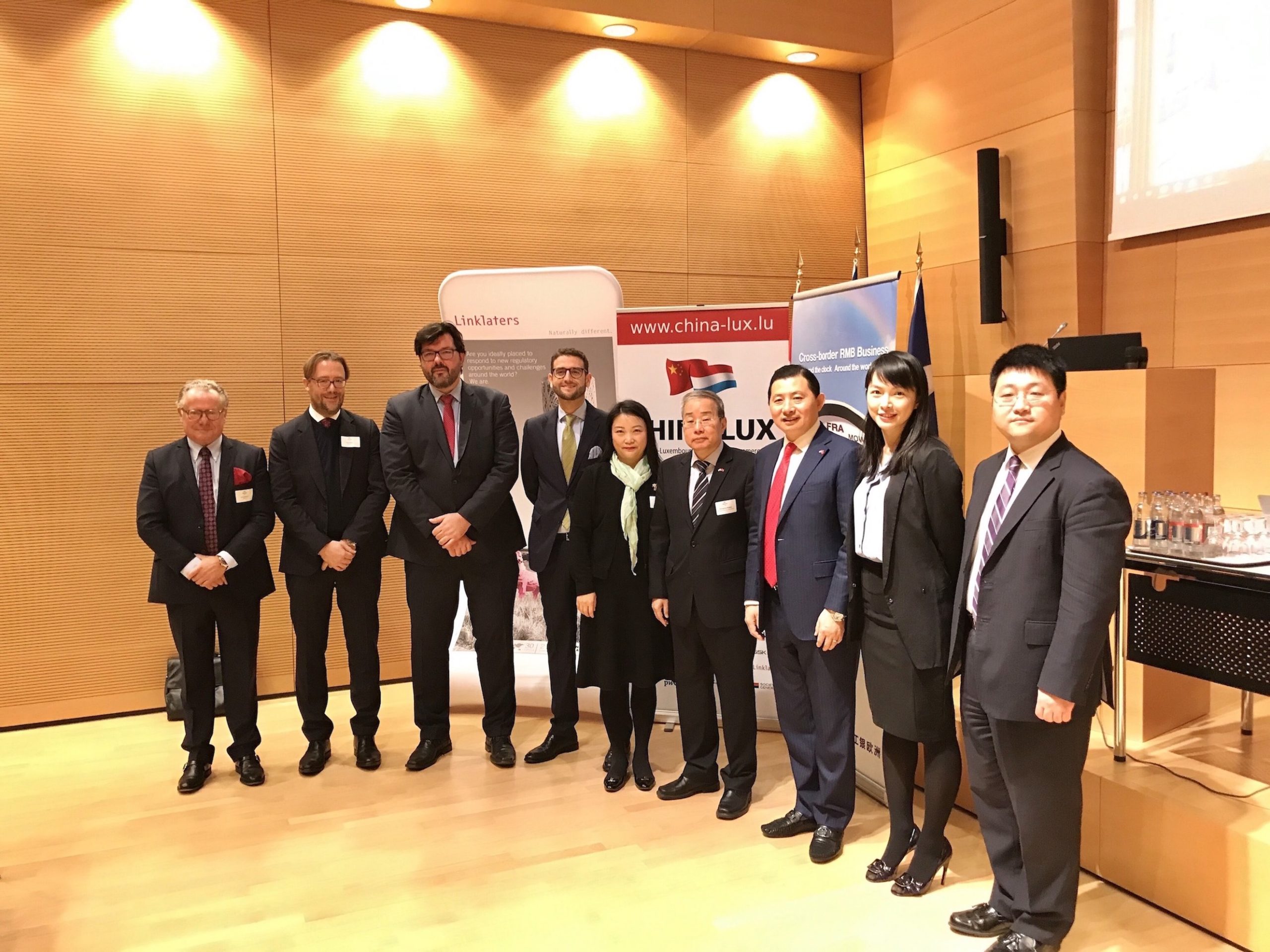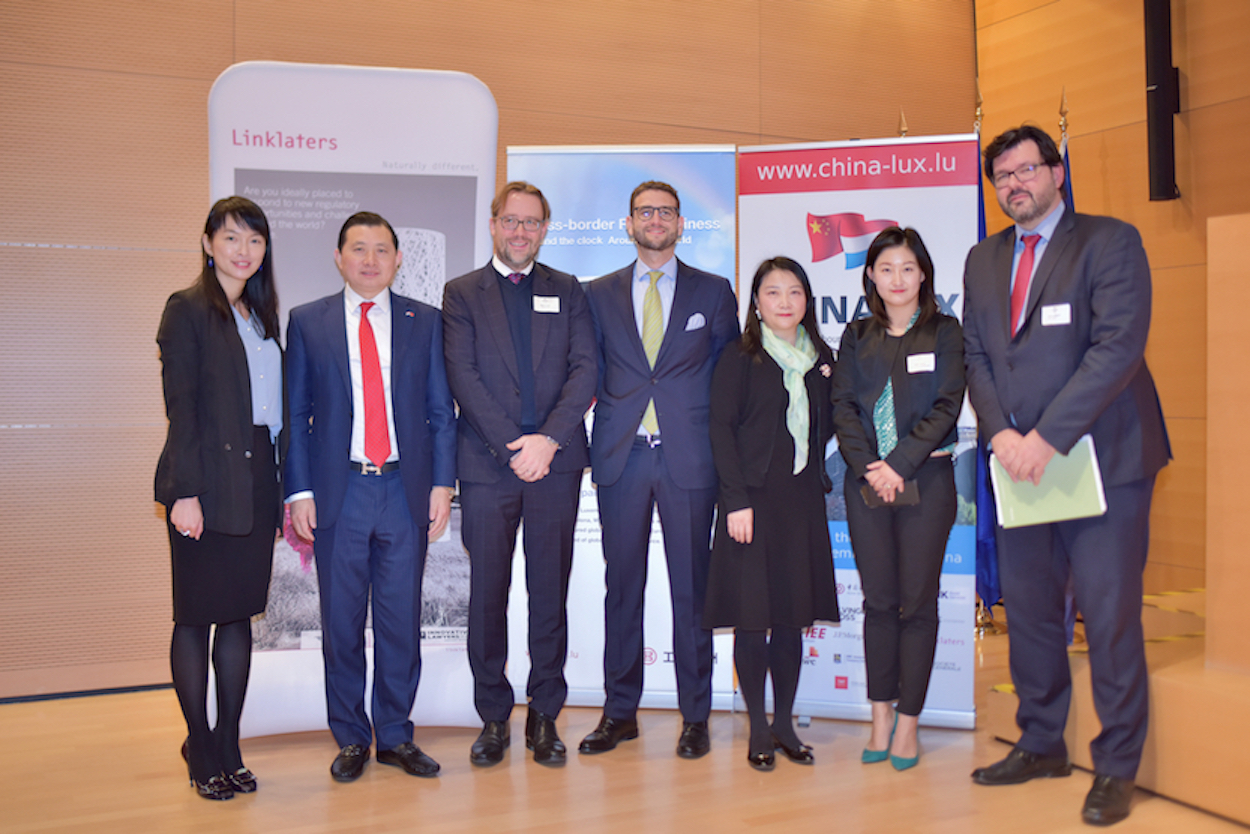 (From left to right) Dirk Dewitte, CHINALUX, Nicki Kayser, Linklaters, Sascha Bremer, Luxembourg for Finance, Fabio Mandorino, ABBL, Li Li, ICBC Europe, H.E. HUANG Changqing, Ambassador of the People's Republic of China to Luxembourg, Professor Bo JI, Cheung Kong Graduate School of Business, Amanda Yeung, CHINALUX, YANG Kaiyu, ICBC Europe.
(From left to right) Dirk Dewitte, CHINALUX, Nicki Kayser, Linklaters, Sascha Bremer, Luxembourg for Finance, Fabio Mandorino, ABBL, Li Li, ICBC Europe, H.E. HUANG Changqing, Ambassador of the People's Republic of China to Luxembourg, Professor Bo JI, Cheung Kong Graduate School of Business, Amanda Yeung, CHINALUX, YANG Kaiyu, ICBC Europe.

(From left to right) Amanda Yeung, CHINALUX, Professor Bo JI, Cheung Kong Graduate School of Business, Nicki Kayser, Linklaters, Fabio Mandorino, ABBL, Li Li, ICBC Europe, Jackie Na LIU, Luxembourg Stock Exchange, Sascha Bremer, Luxembourg for Finance.
CHINALUX 5th BRI Event: Green Finance Seminar was held on 28th November 2018, at Luxembourg Chamber of Commerce. At the beginning, the president of CHINALUX Mr. Dirk Dewitte made a welcome remark to the audience. Mr. Dewitte thanked the organisers, sponsors and attendees for this event. He reviewed CHINALUX last year’s events/activities and gave a overview for next year’s events plan and projects. Mr. Dewitte emphasised that CHINALUX will stay on Top of the Chinese-Luxembourg BRI Strategy.
******************************************************************************************************************************
Professor Bo JI from Cheung Kong Graduate School of Business gave a keynote speech on the topic “China, from red to green”. Professor JI began his speech with the quote “Luxembourg is small but professional and it has strong talent(⼩而精). ” The speech contains four parts:
I. From Red to Green “Red”: in the past, the economy growth was the matter, the GDP was the matter and it became the most important goal for Chinese government, the Chinese people has only focused on contributing to GDP (为了增⻓⽽增长). If we look back the past 10 years of the stock market in China, the line is flat which means what China didn’t make money, it was not profitable.
From the history perspective, back to the QING Dynasty (around 1720), China represented 30% of the global GDP, it was the most powerful country in terms of economy. After, China’s economy had been suffered from the modern history period (1840-1949) where we had Opium War, Culture revolution, etc. the economy started to grow again from 2001 when China joined WTO. China continue to grow, by year of 2024, it will become the largest economy in the world AGAIN.
Today’s conflict: Economy & Environment
With the fast economy developing, the consequences of environment regardless stared to show up, and China has beard these consequences and has realized the important of environment protection. China is the largest CO2 emitter in the world, it has many environmental issues like the water shortage, the environment degradation and the air pollutions, etc. which are the main issues that we are facing right now. This conflict is also global, such as the “London fog in 1952” and the “Rhine river pollution in Germany” which the historical lessons that we have to remember.
Today, China is transforming, from quantity to quality, manufacturing to innovation, from “red economy” to “green economy”, from visible to invisible, from urbanization to rural balance, and from short-term to long term. There are three stages of new China: China 1.0 from 1950 to 1980, and China 2.0 from 1980 to 2010 and China3.0 from 2010 since China joined WTO. In the Paris Agreement COP21, China played the most important role, it made a commitment to the world as a strong example.
II. China’s 13th FYP (five-year plan) is about “go green”, more specifically, we look at the green opportunities and green finance.
13th FYP and low carbon growth China’s “go green” strategy is about:
· Strengthening energy efficiency;
· Implementation of environment protection effort (ex: city solid waste treatment);
· The tackling of the wide gap between the rich and poor (social issue - environment issue - economic issue).
Part of “go green” strategy achievements:
· China has worldwide 5 out of top10 wind turbine companies, 3 out of top 10 solar panel companies;
· For next 5 years, more than double its wind energy capacity, triple its solar and increase Electric Vehicles (ex: BYD - make affordable vehicles for mass market) ;
· over the next 3 years, China plans to cut down 20% coal production;
· China’s green bond market will raise RMB1.5 trillions for renewable energy and environmental projects. China may also become the first countries to issue sovereign Green Bonds.
China supports clean production and low carbon economy, China currently focus on developing renewable energy to meet the plan, such as the solar power, wind power and geothermal. China is already the largest single renewables producer with one third of world’s wind power, one fourth of solar capacities, etc.
“Green” is THE topic at the moment but it won’t last for long, because “in the future, green will be part of finance, it will just be common like the Wi-Fi, there will be no longer “green finance” such term”. The three key players: Environmental Governance, Green Finance, Green technology industry, they stand for policy and regulations, funds and technology. The role of bank here is not only providing the money, the bank itself has to know how business works, it needs to create values and know where to finance.
There is a clear arising of environmental investments: 75.4% goes to air pollution, 14.7% goes to waste water treatment, 17% goes to soil waste and others. The new energy vehicle and the green building materials industries are two main green technology that China attaches importance to. In fact, China is currently the largest Electrical Vehicles market in the world and it has 15% more market share than the EU, by 2020, this figure will increase 10 times than 2015.
Chinese consumers are known to be brand conscious but not brand loyalty, so they are easy to accept the new trend, and with Chinese government’s promotion, the Electrical Vehicles has developed quite smoothly.
III. Green opportunities
There are a lot of business opportunities between western countries and China. China will develop its own style combine with the purchase of core technologies, key parts and energy saving and environmentally friendly equipment from the developed countries: e.g. Maglev Trains, the Compak System.
IV. Green Finance
Starting from 2010, the Green Finance Industry has been taking its shape in China, all 21 major banks in China issued outstanding Green Credit.
The major initiatives of green finance are: establish a green finance system, develop green credit and bonds and set up the green development funds. The green finance should be viewed as the core business, not as the companies’ Corporate Social Responsibility. Only by identifying who is green and who is not, will the market be able to effectively invest funds into the sectors.
Chinese banks are one of the earliest to issue green bonds and stays as a major player in global market, it is the top 10 issuers of the world (20bn USD - China, 15bn USD - France, 5bn USD - Luxembourg). There is also a significant growth of green lending in China. Green bonds are issued to the areas of: pollution, prevention and control 2.6bn USD, clean transportation 2.2bn USD, ecological protection 2.1bn USD, energy saving 2bn USD,resource conservation and recycling 1.7bn USD and clean energy 0.9bn USD.
China takes the lead of the green investment on renewable energy, it has 2.5 times more than EU. China became the world’s largest Green Bonds market in 2016. 250 Green investment funds were launched and 5 provincial Green Finance pilot program were launched in Xinjiang, Guizhou, Jiangxi, Zhejiang and Guangdong.
The green financial system is needed to mobilize the private green investment, it also requires corporation between the government and financial sectors: where is the policy, where is the business.
G20 GFSG (green finance study group)
China proposed to establish GFSG in 2015, 2developing Green Finance is included in G20 Summit. GFSG 2016 suggested 7 options to promote green finance:
1. provide policy to support green investment
2. promote the adoption of green finance principles
3. expand capacity building network
4. develop local currency green bond market
5. promote cross-border green bond investment
6. develop risk analysis capacity
7. improve measurement of green finance
GFSG 2017 added 2 more options and GFSG 2018 added 3 new topics
1. securitization of sustainable assets
2. development of sustainable PEs and VCs
3. application of fin-tech to sustainable finance
In conclusion , China is moving from Red to Green, and environment has taken priority ; Government policy, commercial and individual awareness are changing; There are lots of Green development opportunities in China to seize ; Green finance grows sustainability ; The companies need to find the right way to enter and stay in market.
*******************************************************************************************************************************
After Professor JI’s presentation, a panel discussion on “Green and Sustainable Finance: Luxembourg and China” was held. The general manager of ICBC Europe Mrs. Li LI noted that “Green bond is attractive investment to European investors”.
“Green is about transparency”, Jackie LIU explained how Luxembourg Stock Exchange provide a platform to promote Green Finance investment in Belt and Road countries.
Nicki Kayser, Partner from Linklaters mentioned standards for Green Finance projects including disclosure of how the proceeds is managed and evaluated, also regular reportings. noted how the International Capital Market Association (ICMA) has published Green Bonds Principles (GBP), which are "voluntary process guidelines that recommend transparency and disclosure and promote integrity in the development of the green bond market by clarifying the approach for issuance of a green bond." The GPB are deemed to enable the evaluation of how credible a green bond is, and how the environmental impact develops over time. Furthermore, they should allow for transparency and disclosure, essentially amounting to: where does the money come from? How is it used?
Luxembourg banking sector is committed to Green Finance development.” Noted by Fabio Mandorino, Advisor - Sustainable Finance from ABBL. He emphasized the importance to clarify the rules of the game e.g. what are the green asset?
The Green Finance Seminar closed at 12h30, more than 100 participants attended the event.
Press:
Journal.lu.: Du rouge au vert
Luxtimes: 'Green finance' on silk road to Luxembourg
FOSTERING THE RELATIONSHIP BETWEEN CHINA AND LUXEMBOURG
© 2019 CHINA-LUXEMBOURG CHAMBER OF COMMERCE.